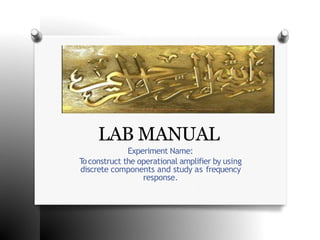
To construct the operational amplifier by using discrete components and study as frequency response.
- 1. LAB MANUAL Experiment Name: T oconstruct the operational amplifier by using discrete components and study as frequency response.
- 2. Amplifier and Discrete components O Amplifier: is an electronic device that increases the voltage, current, or power of a signal. Amplifiers are used in wireless communications and broadcasting, and in audio equipment of all kinds. O Discrete components: An elementary electronic device constructed as a single unit. Before the advent of integrated circuits (chips), all transistors, resistors, capacitors and diodes were discrete. Discrete components are widely used in amplifiers and other electronicproducts that use large amounts ofcurrent.
- 3. Operational Amplifier O Introduction: operational amplifier, also called as an op-amp or op amp . O It is designed for performing operationslike addition, subtraction, integration, differentiation etc. O Amplifier is a voltage amplifying device designed to be used with components like capacitors and resistors, between itsin/out terminals
- 4. Operational Amplifier(741) O 741 Op Amp IC is amonolithic integrated circuit. O It was first manufactured byFairchild semiconductors(company) in 1963. O 741 indicates that this op-amp IC has 7 functional pins, 4 pins capable of taking input and 1 output pin. O IC 741 Op Amp can provide high voltage gain and can be operated over a wide range of voltages, which makes it the best choice for use in integrators & summing amplifiers>
- 5. Operational Amplifier by using discrete components O Pin diagram O standard 741 operational amplifier iscomposed of 20 transistors and 11 resistors. O All of them are integrated into a monolithicchip.
- 6. Circuit diagram of Operational Amplifier(741)
- 7. OT ounderstand the internal circuitrylet’s divide circuit into different blocks. 1. Blue block comprises of adifferential amplifier. 2. Red block comprises currentmirrors. 3. Magenta comprise of class Aamplifier (voltage amplifier) 4. Green and cyan blocks comprises of alevel translator and output amplifier.
- 8. Continued O let’s understand each of theblocks: Deferential amplifier: NPN emitter follower Q1& Q2 which provides high input impedance and provide gain. Common base Q3 & Q4 PNP transistors which are used to drive the active load Q7, Q5, and Q6. Q5 and Q6 perform function of the differential amplifier for the offset null input signal. The current of Q5 & Q6 is controlled by varying a 10k pot connected between input pins 1&5. Q1&Q3 are in series and Q2&Q4 is in series which provides high gain when the input is applied at its input terminals. It can reject common signals
- 9. O Current mirrors(red block): Current mirrors comprise of (Q8-Q9) and (Q12-Q13) areconfigured as Wilson current mirror. Whereas,transistors Q10-Q11 are configured aswider current mirror these current mirrors maintain constant currentto the circuit for stable operation. O voltage amplifier(Magenta block): Q15&Q19 provides voltage gain, transistor Q22 is used to prevent excess current provided toQ20. • Q16 along with 4.5k and 7.5k resistor (known as voltage level shifter), this circuit uses to prevent the output signal fromdistortion.
- 10. Continued O Output amplifier: contain Q14, Q17&Q20 transistor. Q14 & Q20 provides output impedance (typically50-75 Ohms) and current gain. Q17 limits the current at the output. current from Q8 and Q9 is divided into the differential amplifier comprises of (Q1-Q3) & (Q2-Q4). Now the current from the Q3&Q4 is summed with the current of Q10&Q11, Q7 is used to drive Q5 and Q6. The quiescent current is set in Q16 and Q19 is set due to Wilson current mirror (Q12&Q13). The value of 30pFis used for frequency compensation.
- 11. CONFIGURATION OF OP-AMP(IC T womain configurations o f 7o 4p - 1a )m :p O 1) Open-loopconfiguration 2) Close-loopconfiguration 1) Open-loop configuration: in this configuration 741IC can be used as a very high gain amplifier. In open-loop, the gain is ideally infinite hence the output will saturateeither in positive supply voltage or in negative supply voltages. This open-loop system hasthree basic configurations: a)DIFFERENTIAL AMPLIFIER: In this input is applied at both the inputs, which will amplify the difference b/w the two inputs.
- 12. Continued b)NON-INVERTING AMPLIFIER: The input is appliedat the non-invert input terminal. The gain can be calculated using the value of resistors. Rf is feedback resistor. Av= 1+ (Rf /R1) c)INVERTING AMPLIFIER: the input is appliedat inverting terminal. Av= – (Rf / R1) 2)Close-loop configuration: in this configuration, it is connected as negative feedback arrangement. The feedback network is through aresistor.
- 13. CHARACTERISTICSOF IC741(OP-AMP): The characteristics of the IC 741 operational amplifierinclude the following O The Input impedance of the IC 741 op amp is above 100kilo-ohms. O The o/p of the 741 IC op amp is below 100 ohms. O The frequency range of amplifier signals for IC 741op amp is from 0Hz- 1MHz. O The offset current and offset voltage of the IC 741 op amp is low O The voltage gain of the IC 741 is about 2,00,000.
- 14. FREQUENCYRESPONSE: O Frequency response is the quantitative measure of the output spectrum of a system or device in response to a stimulus, and is used to characterize the dynamics of the system. O In open loop, In open loop, the op-amp 741 has very high gain, this response is not very good. T oimprove the gainwe apply negative feedback network, by applying a negative feedback network the gain starts to fall away quite dramatically. The gain is not constant and varies depending on the frequency of input signal. The below graph illustrates the relation betweenthem
- 15. gain remains constant at around 200,000 when the operational amplifier is operated at frequencies below 10Hz. As the frequencyof input signal increases, the gain reduces and approaches unity at frequencies around 100,000Hz. The gain is not constant and varies depending on the frequency of input signal. The below graph illustrates the relation between them
